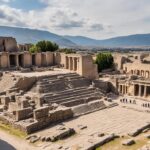Laish, later called Dan, is a biblical city that holds a significant place in the Old Testament. The story of Laish to Dan takes us on a captivating journey through biblical history, offering insights into the Tribe of Dan, their struggles, and their enduring legacy.
Key Takeaways
- Laish, later known as Dan, is a biblical city mentioned in the Old Testament.
- The Tribe of Dan played a significant role in the conquest and transformation of Laish to Dan.
- Exploring the geographical, archaeological, and theological aspects of Laish/Dan enriches our understanding of its historical significance.
- Laish to Dan is relevant to biblical prophecies and has implications for future events.
- The site of Laish/Dan is a popular destination for those interested in biblical history.
The Conquest of Laish by the Tribe of Dan
The conquest of Laish by the tribe of Dan marked a significant turning point in the history of the Tribe of Dan and the Israelite invasion of Canaan. Within fifty years of the initial conquest led by Joshua, the tribe of Dan set their sights on the Canaanite city of Leshem, which later became known as Laish.
Unable to conquer the territory allocated to them in the southern coastal plain, the tribe of Dan sought an alternative conquest, resulting in the capture and renaming of Laish. This conquest showcased the determination and resourcefulness of the tribe as they expanded their territorial reach within the Promised Land.
“And they took the things which Micah had made, and the priest which he had, and came unto Laish, unto a people that were at quiet and secure: and they smote them with the edge of the sword, and burnt the city with fire.” (Judges 18:27)
This conquest not only secured the city of Laish/Dan for the Tribe of Dan but also brought about the integration of their religious practices into the newly acquired territory. The story of the conquest of Laish by the tribe of Dan serves as an important episode in the Old Testament narrative, highlighting the resilience, adaptability, and faith of the Israelites as they established their presence in Canaan.
Geographical Location of Laish/Dan
The biblical city of Laish, later called Dan, was situated in the far north of the land of Canaan. Located on the main trade route from the Galilee to Damascus, Dan became the most significant city in the northern part of the Kingdom of Israel. This strategic positioning expanded the territorial reach of the Israelites all the way from Dan to Beersheba.
“The strategic location of Dan on the main trade route from the Galilee to Damascus made it the most important city in the northern part of the Kingdom of Israel and expanded the territorial reach of the Israelites from Dan to Beersheba.”
Archaeological Discoveries at Dan
The archaeological site at Tel Dan has provided fascinating insights into the ancient Canaanite city of Laish and the subsequent Israelite city of Dan. Excavations have uncovered a plethora of remarkable discoveries, shedding light on the material culture and religious practices of the inhabitants.
The remains of a fortified city with impressive man-made ramparts have been unearthed at Tel Dan. These fortifications not only served as a defensive measure but also provided a glimpse into the architectural prowess of the ancient Canaanites and Israelites.
One of the most well-preserved structures at the site is the intricate city gate complex. The gate, adorned with monumental stone gateways, stood as a grand entrance and exit to the bustling city of Dan. Its meticulous design showcases the advanced engineering techniques employed by these ancient civilizations.
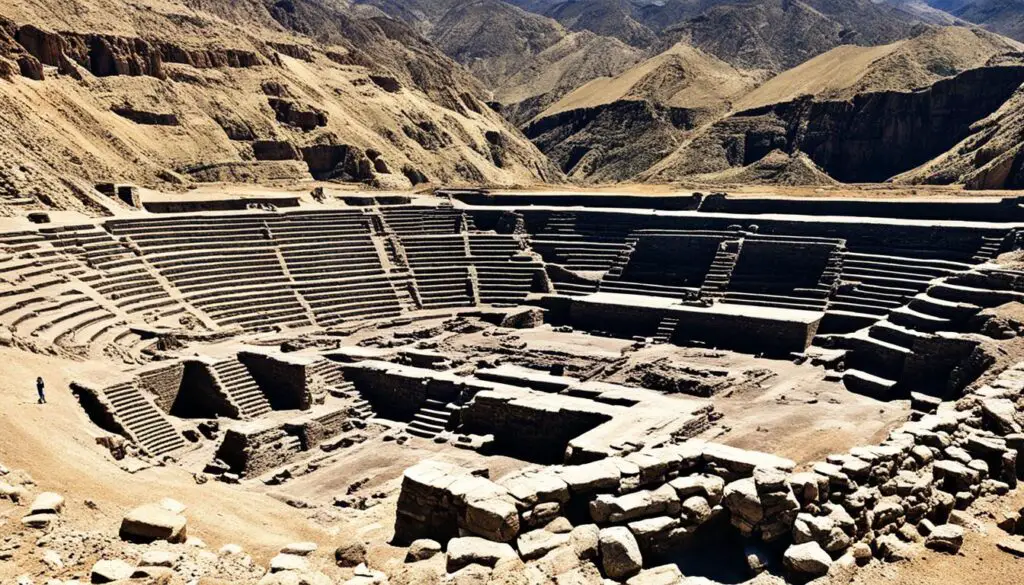
A significant discovery in the archaeological excavations at Dan is a cultic high place associated with Baal worship. This sacred site offers valuable insights into the religious practices and beliefs of the ancient Canaanites and Israelites. The presence of the cultic high place provides evidence of the syncretistic tendencies and the complex interplay between idolatry and true worship during this period.
The archaeological finds at Tel Dan bring the ancient city of Dan to life and provide a deeper understanding of the historical and cultural context of this region. They serve as tangible evidence of the ancient civilizations that once thrived in this ancient Canaanite city turned Israelite stronghold.
Theological Themes in the Story of Laish/Dan
The story of Laish/Dan in the Bible encompasses several profound theological themes that resonate throughout the Old Testament narrative. It sheds light on the importance of Dan as a crucial location and highlights the journey and struggles of the Tribe of Dan as they sought to establish their territory.
The significance of Dan as the northernmost city conquered by the Israelites symbolizes the extent of their territorial reach and the fulfillment of God’s promise to give them possession of the land. The journey of the Tribe of Dan reflects their relentless pursuit of a homeland, a quest that mirrors the faith-dependent pilgrimage of the Israelites.
“And when they came to Laish, they saw the people who were there, how they dwelt safely, in the manner of the Sidonians, quiet and secure. There were no rulers in the land who might put them to shame for anything. They were far from the Sidonians and had no ties with anyone.”
This quote from Judges 18:7 highlights the Tribe of Dan’s reasoning for conquering the city of Laish. It not only reveals their desire for security and prominence but also signifies the adherence to their unique identity and the importance of establishing their own territory.
The religious practices in Laish/Dan, particularly the establishment of a cultic high place dedicated to false worship, exemplify the complex interplay between idolatry and true worship depicted in the Old Testament narrative. This serves as a reminder of the constant struggle between faithfulness to God and the temptation to follow the customs and practices of the surrounding nations.
The journey of Dan and the theological themes within the story intersect with the broader biblical narrative, weaving together aspects of faith, identity, obedience, and God’s covenantal promises. Understanding these theological underpinnings enhances our appreciation for the rich tapestry of the Old Testament and the significant role that Dan played in the history of ancient Israel.
Theological Themes in the Story of Laish/Dan:
| Theological Themes | Description |
|---|---|
| Journey and Struggles of the Tribe of Dan | Highlights the challenges and perseverance of the Tribe of Dan in their pursuit of a territory. |
| Significance of Dan | Symbolizes the territorial extent of the Israelites’ conquest in fulfilling God’s promise. |
| Complex Interplay between Idolatry and True Worship | Reflects the tension between faithfulness to God and the allure of foreign religious practices. |
Key Biblical Events in Laish/Dan
Laish/Dan is associated with several significant events in the Old Testament that contribute to our understanding of the historical, cultural, and religious context of ancient Israel.
- Conquest by the Tribe of Dan
- Destruction and Rebuilding of the City
- Establishment of a Cultic High Place
The conquest of Laish by the tribe of Dan marks a pivotal moment in biblical history. This event showcases the determination of the tribe to find a suitable territory, as they were initially unable to conquer the land allocated to them in the southern coastal plain.
Following the conquest, Laish was destroyed and subsequently rebuilt by the tribe of Dan, reinforcing their presence in the region and solidifying the transition from Laish to Dan as the city’s name.
One of the key events in Laish/Dan’s history was the establishment of a cultic high place. This religious site played a significant role in the spiritual practices of the ancient inhabitants, reflecting the intricate interplay between idolatry and true worship in the Old Testament narrative.
These events serve as important milestones in the biblical narrative, showcasing the determination, resilience, and religious practices of the tribe of Dan in their journey through ancient Israel.
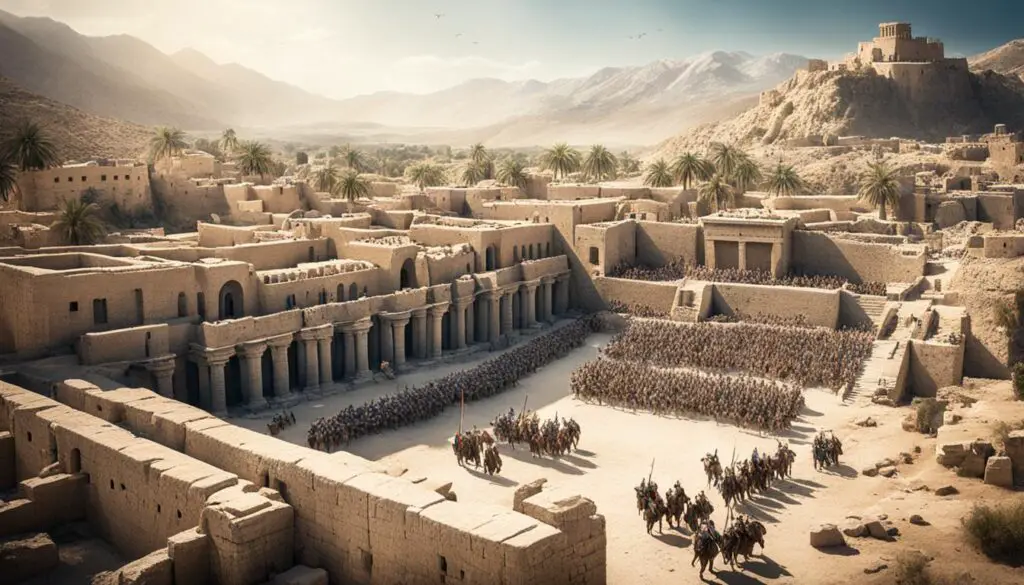
| Event | Description |
|---|---|
| Conquest by the Tribe of Dan | The tribe of Dan conquers the Canaanite city of Laish and renames it Dan, establishing their presence in the northern part of the land. |
| Destruction and Rebuilding of the City | After the conquest, Laish is destroyed and rebuilt as Dan, solidifying the tribe of Dan’s control over the city and the region. |
| Establishment of a Cultic High Place | A cultic high place is established in Dan, becoming a center of religious worship and reflecting the syncretistic religious practices of the time. |
Cultural and Religious Practices in Laish/Dan
The ancient city of Laish, later known as Dan, provides valuable insights into the cultural and religious practices of its inhabitants. Through archaeological discoveries and references in biblical accounts, we can unravel the religious beliefs and customs that shaped the lives of the people in this ancient Israelite city.
Worship of False Gods
Key Keywords: Cultural practices, Religious practices, Baal worship
One prominent aspect of the religious practices in Laish/Dan was the worship of false gods. As archaeological excavations have revealed, silver idols were found within the city, indicating that idolatry played a significant role in the lives of its inhabitants. Of particular importance was the presence of a cultic high place dedicated to the worship of Baal, a Canaanite deity commonly associated with fertility and nature.
“The presence of a cultic high place for Baal worship in Laish/Dan highlights the syncretistic tendencies of the Israelites during this period. It reflects the complex interplay between Canaanite and Israelite cultures, as well as the challenges faced in maintaining monotheism.”
Syncretism in Dan
Key Keywords: Cultural practices, Religious practices, Ancient Israelite city
The cultural practices of the ancient inhabitants of Dan were influenced by both Canaanite and Israelite traditions. The syncretistic nature of the religious practices in Dan is evident in the presence of idols associated with Canaanite deities alongside the worship of the God of Israel. This blending of beliefs and practices highlights the challenges faced by the Israelites in maintaining their monotheistic faith.
The complex blend of cultures in Dan provides a window into the religious dynamics of ancient Israel. It reminds us that cultural practices and religious beliefs are not fixed, but evolve and intersect in response to the surrounding influences and contexts.
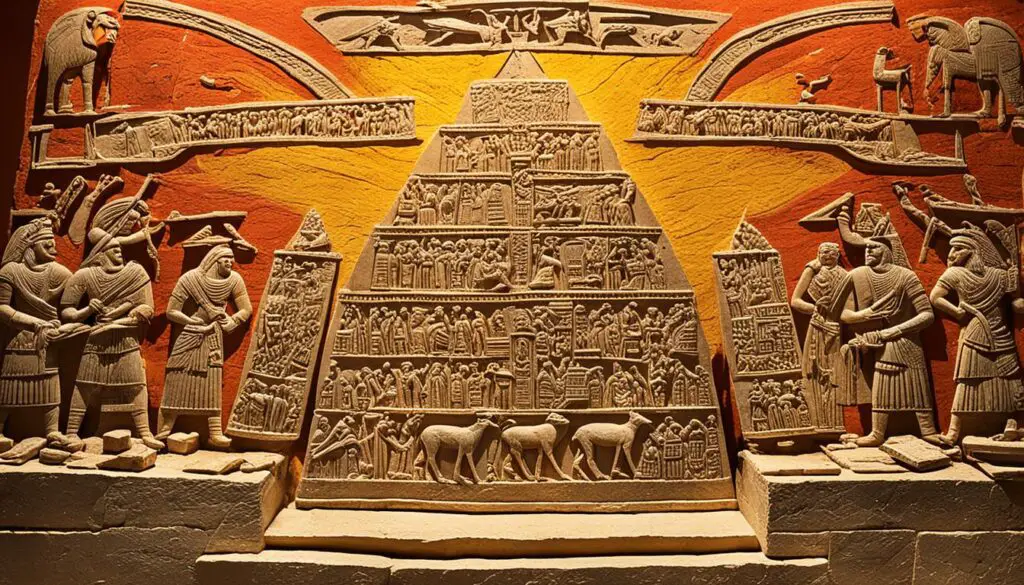
Comparative Analysis of Cultural and Religious Practices in Laish/Dan
| Aspect | Canaanite Influence | Israelite Influence |
|---|---|---|
| Idol Worship | High | Medium |
| Cultic Practices | High | Medium |
| Monotheistic Tendencies | Low | High |
The table above provides a comparative analysis of the cultural and religious practices in Laish/Dan, highlighting the degree of Canaanite and Israelite influences in different aspects. It reveals the dominance of Canaanite practices in idol worship and cultic rituals, while also showcasing the Israelite emphasis on monotheism.
Understanding the cultural and religious practices in Laish/Dan allows us to grasp the complexities of ancient Israelite society and the challenges they faced in navigating their faith amidst surrounding influences. It serves as a reminder of the fluid and dynamic nature of cultural practices and religious beliefs throughout history.
Prophetic and Eschatological Significance of Laish/Dan
The city of Laish, later known as Dan, holds profound prophetic and eschatological significance in biblical texts. It is mentioned in various prophecies that relate to the restoration of Israel and the coming of the Messiah. Exploring the location and history of Laish/Dan provides a backdrop for understanding these prophecies and their implications for future events.
The transformation of Laish to Dan, a significant conquest by the Tribe of Dan, is not only a historical event but also carries profound theological implications. The name change from Laish to Dan was not merely a symbolic act, but rather a manifestation of God’s plan for the future of Israel.
In the Book of Judges, we find a prophecy attributed to Samson regarding the Tribe of Dan and their inheritance in the land of Canaan. Judges 18:27-29 states:
“Then they took what Micah had made, and his priest, and went to Laish, against a people quiet and unsuspecting, and struck them with the edge of the sword and burned the city with fire. And there was no deliverer because it was far from Sidon, and they had no dealings with anyone. It was in the valley that belongs to Beth-rehob. Then they rebuilt the city and lived in it. And they named the city Dan, after the name of Dan their ancestor, who was born to Israel; but the name of the city was Laish at the first.”
The fulfillment of this prophecy highlights the significant role of Laish/Dan in the restoration of Israel and the establishment of the Messianic kingdom. It serves as a reminder of God’s faithfulness to His promises and His sovereign plan for His people.
Furthermore, Laish/Dan is mentioned in other biblical prophecies that foreshadow the end times and the coming of the Messiah. For example, Jeremiah 8:16 states:
“The snorting of their horses is heard from Dan; at the sound of the neighing of their stallions the whole land quakes. They come and devour the land and all that fills it, the city and those who dwell in it.”
This passage refers to the Babylonian invasion of Judah and serves as a warning of imminent judgment. However, it also holds a future eschatological significance, as it echoes the imagery of the end times and the events preceding the return of Christ.
Understanding the prophetic and eschatological significance of Laish/Dan enriches our interpretation of biblical prophecies and deepens our understanding of God’s plan for His people. The historical context and location of Laish/Dan provide valuable insights into these prophecies, serving as a reminder of the intricate tapestry woven throughout the biblical narrative.
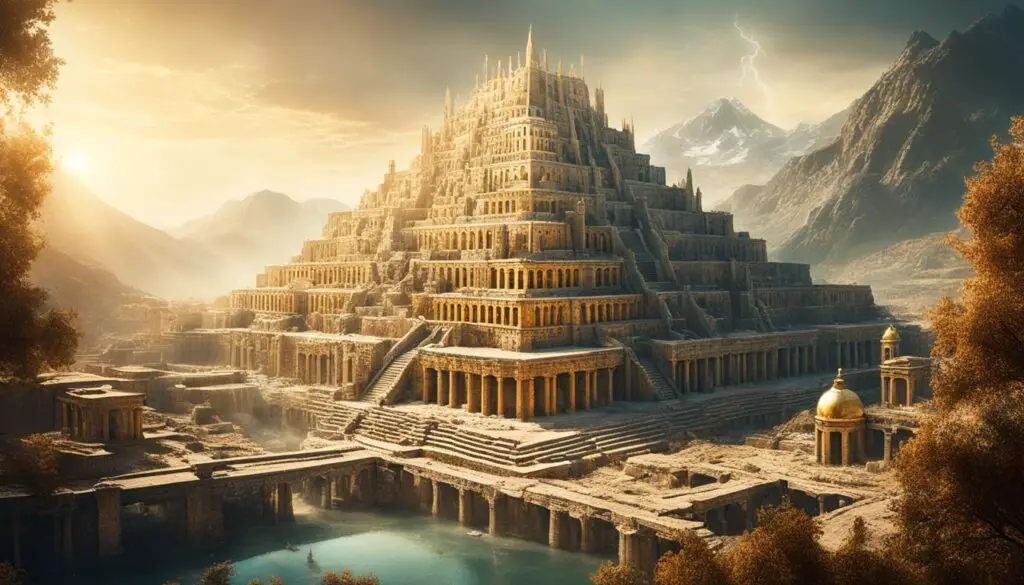
Key Prophecies Related to Laish/Dan:
- The transformation of Laish to Dan by the Tribe of Dan (Judges 18:27-29)
- The mention of Dan in the context of the end times and the coming of the Messiah (Jeremiah 8:16)
- Other prophecies that relate to the restoration of Israel and the establishment of the Messianic kingdom
Modern Significance and Visit to Laish/Dan
The archaeological site of Laish/Dan holds great significance for modern visitors interested in biblical history. Excavations have made it one of the most attractive historical sites in Israel, attracting tourists from around the world. The modern significance of Laish/Dan lies in its ability to provide a window into the ancient biblical world, allowing visitors to immerse themselves in the rich history and legacy of the Tribe of Dan.
Exploring the ruins of the ancient city offers a unique opportunity to connect with the past and gain a deeper understanding of the Old Testament narrative. As you walk among the remnants of the fortified city and ancient structures, you can envision the daily life of the Israelites who once inhabited this land. The archaeological discoveries, ongoing excavations, and preservation efforts contribute to a greater comprehension of the biblical events that unfolded in Laish/Dan.
Visiting Laish/Dan is like taking a step back in time. You can witness the grandeur of the Israelite city wall, the intricate architecture of the monumental stone gateways, and even the remnants of the cultic high place where religious practices took place. These tangible remnants transport you to a different era and allow you to contemplate the cultural, religious, and historical significance of Laish/Dan in the biblical narrative.

Conclusion
The transformation of Laish to the biblical city of Dan stands as a testament to the rich history and enduring legacy of the Tribe of Dan in the Old Testament. This remarkable journey encompasses the conquest of Laish by the tribe of Dan, the establishment of a cultic high place, and the complex interplay of geographical, archaeological, and theological elements.
By exploring the geographical location of Laish/Dan, we gain insights into its strategic significance as the northernmost city conquered by the Israelites. The archaeological discoveries at Tel Dan reveal the material culture and religious practices of its ancient inhabitants, shedding light on the syncretistic tendencies of the Israelites during this period.
The theological themes woven into the story of Laish/Dan highlight the journey and struggles of the Tribe of Dan, symbolizing the extent of the Israelites’ territorial reach. Furthermore, its prophetic and eschatological significance found in biblical texts deepens our understanding of the restoration of Israel and the coming of the Messiah.
FAQ
What is the significance of the transformation of Laish to the city of Dan in the Bible?
The transformation of Laish to the city of Dan marked a significant turning point in the history of the Tribe of Dan and expanded the territorial reach of the Israelites. It holds important theological and historical significance in the biblical narrative.
Where was Laish, later known as Dan, located?
Laish, later known as Dan, was located in the far north of the land of Canaan. It was strategically positioned on the main trade route from the Galilee to Damascus, making it the most important city in the northern part of the Kingdom of Israel.
What have archaeological excavations revealed about the ancient city of Dan?
Excavations at Tel Dan have uncovered extensive remains of the ancient Canaanite city of Laish and the subsequent Israelite city of Dan. These discoveries include fortified structures, city gates, monumental stone gateways, and a cultic high place associated with Baal worship.
What theological themes can be found in the story of Laish/Dan in the Bible?
The story of Laish/Dan highlights the journey and struggles of the Tribe of Dan as they searched for a territory to settle. It also emphasizes the territorial reach of the Israelites and the complex interplay between idolatry and true worship in the Old Testament narrative.
What key events in the Old Testament are associated with Laish/Dan?
Laish/Dan is associated with several significant events, including the conquest by the tribe of Dan, the destruction and rebuilding of the city, and the establishment of a cultic high place. These events contribute to our understanding of the historical and religious context of ancient Israel.
What cultural and religious practices can be learned from Laish/Dan?
The archaeological discoveries and biblical accounts of Laish/Dan provide insights into the worship of false gods, such as Baal, and the syncretistic tendencies of the Israelites during that time. They reflect the complex blend of Canaanite and Israelite cultures in the city.
What is the prophetic and eschatological significance of Laish/Dan?
Laish/Dan is mentioned in various prophecies related to the restoration of Israel and the coming of the Messiah. The location and history of Laish/Dan provide a backdrop for understanding these prophecies and their implications for future events.
Why is the archaeological site of Laish/Dan significant for modern visitors?
The ongoing excavations at the site of Laish/Dan make it one of the most attractive archaeological sites in Israel. Exploring the ruins of the ancient city offers a unique opportunity to connect with the history and legacy of the Tribe of Dan and to deepen one’s understanding of biblical history.
What is the conclusion of the transformation of Laish to the city of Dan?
The transformation of Laish to the city of Dan is a testament to the rich history and legacy of the Tribe of Dan in the Old Testament. It evidences the importance of the city in the biblical narrative and provides valuable insights into the historical, cultural, and religious context of ancient Israel.




